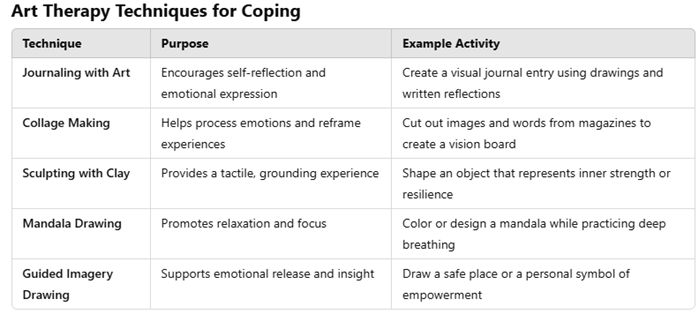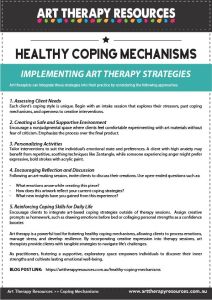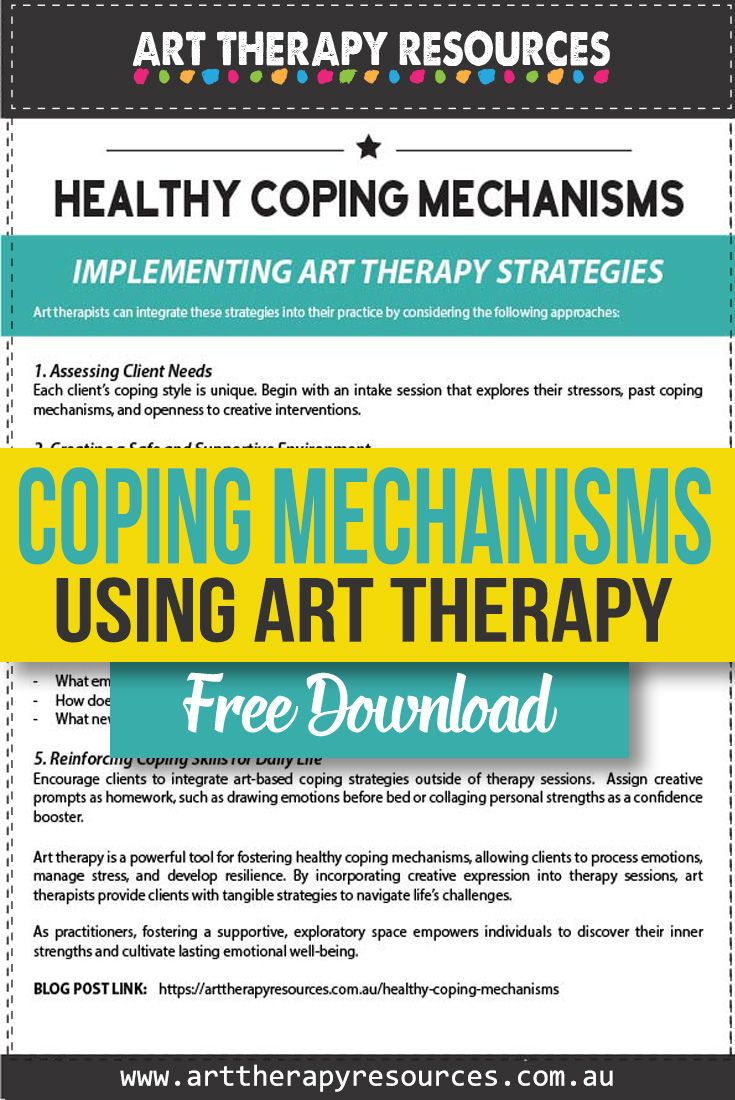THIS POST INCLUDES:
1. Understanding Coping Mechanisms
2. The Role of Art Therapy
3. Implementing Art Therapy for Coping
4. Free Download Healthy Coping Mechanisms
UNDERSTANDING COPING MECHANISMS
Life is filled with inevitable challenges, from daily stressors to major life transitions. The way individuals cope with these difficulties significantly impacts their emotional and psychological well-being. While some people naturally develop adaptive strategies—such as talking through their feelings, engaging in exercise, or practicing mindfulness—others may struggle with maladaptive coping mechanisms, such as avoidance, emotional suppression, or substance use. Over time, these unhealthy behaviors can contribute to increased stress, anxiety, and even mental health disorders.
Art therapy provides a structured yet flexible way for individuals to explore, understand, and manage their emotions through creative expression. Unlike traditional talk therapy, which primarily relies on verbal processing, art therapy engages clients in a visual and tactile exploration of their internal experiences. This creative approach allows for deeper self-reflection, emotional release, and the development of new, constructive coping mechanisms.
For art therapists, integrating artistic practices into sessions can help clients build resilience, regulate their emotions, and develop a stronger sense of self-awareness. Through painting, drawing, sculpting, or other forms of artistic expression, clients can externalize their emotions in a safe and nonjudgmental space. By doing so, they learn to process complex feelings in a healthy way, ultimately empowering them to handle life’s challenges with greater confidence and stability.
UNDERSTANDING COPING MECHANISMS
Coping mechanisms refer to the thoughts and behaviors individuals use to manage stress, emotional discomfort, and challenging life experiences. While everyone develops their own ways of handling adversity, coping strategies generally fall into two broad categories:
Healthy Coping Mechanisms
Healthy coping mechanisms support emotional well-being and help individuals manage stress in constructive ways. These strategies promote self-awareness, emotional regulation, and resilience. Examples include:
- Mindfulness and Relaxation Techniques – Practicing deep breathing, meditation, or progressive muscle relaxation to calm the nervous system and reduce stress.
- Problem-Solving – Identifying the root cause of stress and taking proactive steps to address or adapt to the situation.
- Seeking Social Support – Talking to trusted friends, family members, or a therapist for emotional support and guidance.
- Physical Activity – Engaging in exercise, yoga, or even a simple walk to release built-up tension and improve mood.
- Creative Expression – Using art, music, writing, or dance to process emotions, explore thoughts, and gain clarity on difficult experiences.
- Journaling – Writing down thoughts and feelings to gain insight into personal challenges and track emotional progress.
Unhealthy Coping Mechanisms
Unhealthy coping mechanisms may provide temporary relief but often lead to long-term emotional distress or harm. These strategies can prevent individuals from fully processing their emotions, exacerbating feelings of anxiety, depression, or frustration. Examples include:
- Avoidance – Ignoring or suppressing emotions rather than addressing them, which can lead to increased stress and unresolved trauma.
- Self-Isolation – Withdrawing from social connections and support networks, which can contribute to feelings of loneliness and despair.
- Aggression or Outbursts – Expressing frustration through yelling, verbal abuse, or physical aggression, often leading to damaged relationships and further emotional distress.
- Substance Use – Relying on alcohol, drugs, or excessive food consumption to numb difficult emotions rather than processing them in a healthy manner.
- Self-Destructive Behaviors – Engaging in risky activities, self-harm, or other actions that compromise physical and emotional well-being.
Art therapy offers a safe and productive way for clients to explore their emotions and develop adaptive coping strategies that align with their personal needs and circumstances. By replacing unhealthy coping mechanisms with creative and expressive outlets, individuals can gain control over their emotional responses, develop problem-solving skills, and build resilience in the face of life’s challenges.
THE ROLE OF ART THERAPY
1. Enhancing Emotional Expression
Many clients struggle to articulate their emotions verbally. Art therapy provides an alternative means of expression, enabling individuals to process their experiences through colors, shapes, and textures. For example, a client experiencing grief may find solace in creating a memory collage that honors their lost loved one.
2. Reducing Stress and Anxiety
The process of creating art has been shown to lower cortisol levels and promote relaxation. Engaging in rhythmic and repetitive activities such as mandala coloring or clay sculpting can help regulate the nervous system and foster a sense of calm.
3. Building Self-Awareness and Reflection
Art therapy encourages introspection, allowing clients to examine patterns in their thoughts and behaviors. By analyzing their artwork, individuals can gain insights into their coping styles and identify areas for personal growth. A therapist might guide a client in journaling about their artwork to deepen this self-exploration.
4. Strengthening Problem-Solving Skills
Art-making encourages cognitive flexibility and problem-solving. When clients experiment with different artistic techniques, they learn to approach challenges from new perspectives. For instance, working with mixed media might teach a client to embrace imperfection and adaptability in both art and life.
5. Encouraging Mindfulness and Present-Moment Awareness
Mindfulness-based art therapy (MBAT) integrates mindfulness principles with creative expression. Clients are encouraged to focus on the process rather than the final product, fostering a nonjudgmental awareness of their thoughts and emotions. Techniques such as mindful doodling or painting to music can help clients stay present and engaged.

IMPLEMENTING ART THERAPY STRATEGIES
Art therapists can integrate these strategies into their practice by considering the following approaches:
1. Assessing Client Needs
Each client’s coping style is unique. Begin with an intake session that explores their stressors, past coping mechanisms, and openness to creative interventions.
2. Creating a Safe and Supportive Environment
Encourage a nonjudgmental space where clients feel comfortable experimenting with art materials without fear of criticism. Emphasize the process over the final product.
3. Personalizing Activities
Tailor interventions to suit the individual’s emotional state and preferences. A client with high anxiety may benefit from repetitive, soothing techniques like Zentangle, while someone experiencing anger might prefer expressive, bold strokes with acrylic paint.
4. Encouraging Reflection and Discussion
Following an art-making session, invite clients to discuss their creations. Use open-ended questions such as:
- What emotions arose while creating this piece?
- How does this artwork reflect your current coping strategies?
- What new insights have you gained from this experience?
5. Reinforcing Coping Skills for Daily Life
Encourage clients to integrate art-based coping strategies outside of therapy sessions. Assign creative prompts as homework, such as drawing emotions before bed or collaging personal strengths as a confidence booster.
Art therapy is a powerful tool for fostering healthy coping mechanisms, allowing clients to process emotions, manage stress, and develop resilience. By incorporating creative expression into therapy sessions, art therapists provide clients with tangible strategies to navigate life’s challenges. As practitioners, fostering a supportive, exploratory space empowers individuals to discover their inner strengths and cultivate lasting emotional well-being.
FREE DOWNLOAD: Art Therapy Exercise
SIGN UP below to gain access to our RESOURCE LIBRARY and download the FREE Healthy Coping Mechanisms Handout.

BUILD YOUR ART THERAPY REFERENCE MATERIALS:
Pin this image to your Pinterest board.

SHARE KNOWLEDGE & PASS IT ON:
If you’ve enjoyed this post, please share it on Facebook, Twitter, Pinterest. Thank you!
